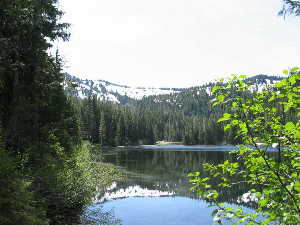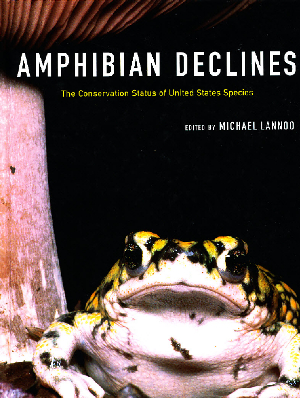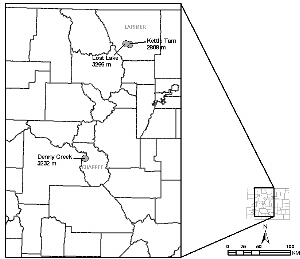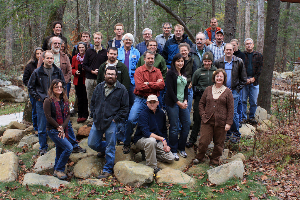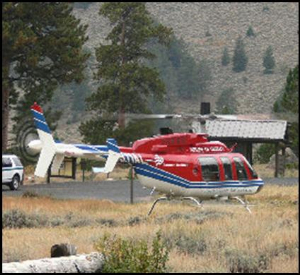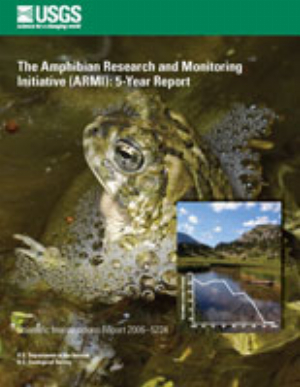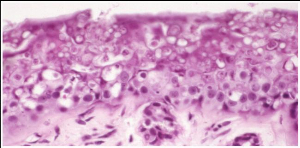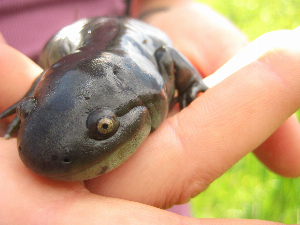Search ARMI Database
Search term(s)
Contribution Number
Search Results
879 record(s) found.
Papers & Reports Optical characteristics of natural waters can protect amphibian populations from UV-B in the US Pacific Northwest
Authors: Wendy J Palen; D E Schindler; Michael J Adams; Christopher A Pearl; Richard B Bury; S Diamond
Date: 2002 | Outlet: Ecology 83: 2951-2957
Increased exposure to ultraviolet-B (UV-B) radiation has been proposed as a major environmental stressor leading to global amphibian declines. Prior experimental evidence from the US Pacific Northwest (PNW) has established the embryonic sensitivity of at least 4 amphibian species to UV-B and has been central to the amphibian decline literature. However, these results have not been expanded to address population-scale effects and natural landscape variation in UV-B transparency of water at amphibian breeding sites; necessary links to assess the importance of UV-B for amphibian declines. We quantified the UV-B transparency of 136 potential amphibian breeding sites to establish the pattern of UV-B exposure across two montane regions in the PNW. Our data suggest that 85% of sites are naturally protected by dissolved organic matter (DOM) in pond water, and that only a fraction of breeding sites are likely to experience UV-B intensities exceeding levels associated with elevated egg mortality. Thus, the spectral characteristics of natural waters mediate the physiological effects of UV-B on amphibian eggs in all but the clearest sites. These data imply that UV-B is unlikely to cause broad amphibian declines across the landscape of the American Northwest.
Papers & Reports Bufo baxteri Porter, 1968, Wyoming toad
Authors: R A Odum; P. Stephen Corn
Date: 2005 | Outlet: Lannoo M, editor. Amphibian declines: the conservation status of United States species. Berkeley: University of California Press 390–392
Species account of the Endangered Wyoming Toad.
Papers & Reports Estimating site occupancy and detection probability parameters for mammals in a coastal ecosystem.
Authors: A F O'Connell; N W Talancy; Larissa L Bailey; J R Sauer; R Cook; A T Gilbert
Date: 2007 | Outlet: Journal of Wildlife Management 70: 1625-1633
Papers & Reports Multi-scale occupancy estimation and modeling using multiple detection methods.
Authors: J D Nichols; Larissa L Bailey; A F O’Connell; N W Talancy; Evan HC Grant; A T Gilbert; E M Annand; T P Husband; J E Hines
Date: 2008 | Outlet: Journal of Applied Ecology 45: 1321-1329
Papers & Reports Designing monitoring programs to assess reintroduction efforts: a critical component in recovery
Authors: Erin Muths; V J Dreitz
Date: 2008 | Outlet: Animal Biodiversity and Conservation 31: 47–56
Reintroduction is a powerful tool in our conservation toolbox. However, the necessary follow-up, i.e. long-term monitoring, is not commonplace and if instituted may lack rigor. We contend that valid monitoring is possible, even with sparse data. We present a means to monitor based on demographic data and a projection model using the Wyoming toad (Bufo baxteri) as an example. Using an iterative process, existing data is built upon gradually such that demographic estimates and subsequent inferences increase in reliability. Reintroduction and defensible monitoring may become increasingly relevant as the outlook for amphibians, especially in tropical regions, continues to deteriorate and emergency collection, captive breeding, and reintroduction become necessary. Rigorous use of appropriate modeling and an adaptive approach can validate the use of reintroduction and substantially increase its value to recovery programs.
Papers & Reports Estimation of the probability of male toads to return to the breeding site
Authors: Erin Muths; R D Scherer; P. Stephen Corn; Brad A Lambert
Date: 2006 | Outlet: Ecology 87: 1048–1056
Male boreal toads are thought to return to the breeding site year after year and, if absent in a particular year, be more likely to be present the following year. Using Pollock’s robust design we estimated temporary emigration (the probability a male toad is absent from a breeding site in a given year) at locations in Colorado: Rocky Mountain National Park (n=2) and Chaffee County (n=1). We present data that suggest that male toads do not return to the breeding site every year. Estimates of both temporary emigration parameters ( ’ = probability that a male toad is absent from the breeding site at time i if absent at time i - 1; ” = probability that a male toad is absent at time i if present at time i - 1) varied by site and time (for example, at Lost Lake, the probability of temporary emigration ranged from 10 - 29%). Although we suspected that the probability of temporary emigration would be state dependent (Markovian temporary emigration, e.g. whether a male toad is at the breeding site at time i is affected by whether it was at the breeding site at time i - 1), the data showed greater support for models of random temporary emigration or no emigration. However, some models of Markovian emigration were supported. We also hypothesized relationships between temporary emigration and a number of environmental variables. While some competitive models included environmental covariates, model selection uncertainty precluded fully defining the role of these covariates in temporary emigration.
Papers & Reports Environmental limitations of an amphibian pathogen in the Rocky Mountains, U.S.A
Authors: Erin Muths; David S Pilliod; L J Livo
Date: 2008 | Outlet: Biological Conservation 141: 1484–1492
Amphibian populations continue to be imperiled by the chytrid fungus (Batrachochytrium dendrobatidis). Understanding where B. dendrobatidis (Bd) occurs and how it may be limited by environmental factors is critical to our ability to effectively conserve the amphibians affected by Bd. We sampled 1247 amphibians (boreal toads and surrogates) at 261 boreal toad (Bufo boreas) breeding sites (97 clusters) along an 11o latitudinal gradient in the Rocky Mountains to determine the distribution of B. dendrobatidis and examine environmental factors, such as temperature and elevation, that might affect its distribution. The fungus was detected at 63% of all clusters and occurred across a range of elevations (1030–3550 m) and latitudes (37.6–48.6 o) but we detected it in only 42% of clusters in the south (site elevations higher), compared to 84% of clusters in the north (site elevations lower). Maximum ambient temperature (daily high) explained much of the variation in Bd occurrence in boreal toad populations and thus perhaps limits the occurrence of the pathogen in the Rocky Mountains to areas where climatic conditions facilitate optimal growth of the fungus. This information has implications in global climate change scenarios where warming temperatures may facilitate the spread of disease into previously un- or little-affected areas (i.e., higher elevations). This study provides the first regional-level, field-based effort to examine the relationship of environmental and geographic factors to the distribution of B. dendrobatidis in North America and will assist managers to focus on at-risk populations as determined by the local temperature regimes, latitude and elevation.
Papers & Reports Bufo boreas Baird and Girard, 1852(b), western toad
Authors: Erin Muths; Priya Nanjappa
Date: 2005 | Outlet: Lannoo M, editor. Amphibian declines: the conservation status of United States species. Berkeley: University of California Press 392–396
Species account for Bufo(Anaxyrus)boreas
Papers & Reports The U.S. Department of Interior’s Amphibian Research and Monitoring Initiative: a successful start to a national program
Authors: Erin Muths; R E Jung; Larissa L Bailey; Michael J Adams; P. Stephen Corn; Kenneth C Dodd; Gary M Fellers; Walt J Sadinski; Cecil R Schwalbe; Susan C Walls; Robert N Fisher; A L Gallant; William A Battaglin; David E Green
Date: 2005 | Outlet: Applied Herpetology 2: 355–371
Most research to assess amphibian declines has focused on local-scale projects on one or a few species. The Amphibian Research and Monitoring Initiative (ARMI) is a national program in the United States mandated by congressional directive and implemented by the U.S. Department of the Interior (specifically the U.S. Geological Survey, USGS). Program goals are to monitor changes in populations of amphibians across U.S. Department of the Interior lands and to address research questions related to amphibian declines using a hierarchical framework of base-, mid- and apex-level monitoring sites. ARMI is currently monitoring 83 amphibian species (29% of species in the U.S.) at mid- and apex-level areas. We chart the progress of this 5-year-old program and provide an example of mid-level monitoring from 1 of the 7 ARMI regions.
Papers & Reports Experimental repatriation of boreal toad (Bufo boreas) eggs, metamorphs, and adults in Rocky Mountain National Park
Authors: Erin Muths; T L Johnson; P. Stephen Corn
Date: 2001 | Outlet: Southwestern Naturalist 46: 106–113
The boreal toad (Bufo boreas) is an endangered species in Colorado and is considered a candidate species for federal listing by the United States Fish and Wildlife Service. Boreal toads are absent from many areas of suitable habitat in the Southern Rocky Mountains of Colorado presumably due to a combination of causes. We moved boreal toads from existing populations and from captive rearing facilities to habitat which was historically, but is not currently, occupied by toads to experimentally examine methods of repatriation for this species.
Papers & Reports The amphibian research and monitoring initiative (ARMI): 5-year report
Authors: Erin Muths; A L Gallant; Evan HC Grant; J S Staiger; William A Battaglin; David E Green; Susan C Walls; Margaret S Gunzburger; R F Kearney
Date: 2006 | Outlet: U.S. Geological Survey Scientific Investigations Report 2006-5224 75
The Amphibian Research and Monitoring Initiative (ARMI) is an innovative, multidisciplinary program that began in 2000 in response to a congressional directive for the Department of the Interior to address the issue of amphibian declines in the United States. ARMI’s formulation was cross-disciplinary, integrating U.S. Geological Survey scientists from Biology, Water, and Geography to develop a course of action (Corn and others, 2005a). The result has been an effective program with diverse, yet complementary, expertise.
ARMI’s approach to research and monitoring is multiscale. Detailed investigations focus on a few species at selected local sites throughout the country; monitoring addresses a larger number of species over broader areas (typically, National Parks and National Wildlife Refuges); and inventories to document species occurrence are conducted more extensively across the landscape. Where monitoring is conducted, the emphasis is on an ability to draw statistically defensible conclusions about the status of amphibians. To achieve this objective, ARMI has instituted a monitoring response variable that has nationwide applicability. At research sites, ARMI focuses on studying species/environment interactions, determining causes of observed declines, and developing new techniques to sample populations and analyze data. Results from activities at all scales are provided to scientists, land managers, and policymakers, as appropriate.
The ARMI program and the scientists involved contribute significantly to understanding amphibian declines at local, regional, national, and international levels. Within National Parks and National Wildlife Refuges, findings help land managers make decisions applicable to amphibian conservation. For example, the National Park Service (NPS) selected amphibians as a vital sign for several of their monitoring networks, and ARMI scientists provide information and assistance in developing monitoring methods for this NPS effort. At the national level, ARMI has had major exposure at a variety of meetings, including a dedicated symposium at the 2004 joint meetings of the Herpetologists’ League, the American Society of Ichthyologists and Herpetologists, and the Society for the Study of Amphibians and Reptiles. Several principal investigators have brought international exposure to ARMI through venues such as the World Congress of Herpetology in South Africa in 2005 (invited presentation by Dr. Gary Fellers), the Global Amphibian Summit, sponsored by the International Union for Conservation of Nature (IUCN) and Wildlife Conservation International, in Washington, D.C., 2005 (invited participation by Dr. P.S. Corn), and a special issue of the international herpetological journal Alytes focused on ARMI in 2004 (edited by Dr. C.K. Dodd, Jr.).
ARMI research and monitoring efforts have addressed at least 7 of the 21 Threatened and Endangered Species listed by the U.S. Fish and Wildlife Service (California red-legged frog [Rana draytonii ], Chiricahua leopard frog [R. chiricahuensis], arroyo toad [Bufo californicus], dusky gopher frog [Rana sevosa], mountain yellow-legged frog [R. muscosa], flatwoods salamander [Ambystoma cingulatum], and the golden coqui [Eleutherodactylus jasperi]), and 9 additional species of concern recognized by the IUCN. ARMI investigations have addressed time-sensitive research, such as emerging infectious diseases and effects on amphibians related to natural disasters like wildfire, hurricanes, and debris flows, and the effects of more constant, environmental change, like urban expansion, road development, and the use of pesticides.
Over the last 5 years, ARMI has partnered with an extensive list of government, academic, and private entities. These partnerships have been fruitful and have assisted ARMI in developing new field protocols and analytic tools, in using and refining emerging technologies to improve accuracy and efficiency of data handling, in conducting amphibian disease, malformation, and environmental effects research, and in implementing a network of monitoring and research sites. Accomplishments from these endeavors include more than 40 publications on amphibian status and trends, nearly 100 publications on amphibian ecology and causes of declines, and over 30 methodological publications. Several databases have emerged as a result of ARMI and its partnerships; one, a digital atlas of ranges for all U.S. amphibian species, was used by the IUCN to display amphibian distribution maps in the Global Amphibian Assessment Project.
Given the scope of ARMI and the panoply of projects, findings have had implications for policy. Investigations that demonstrate amphibian declines or illuminate causes of declines provide valuable information about habitat management, environmental effects, mechanisms for the spread of disease, and human/amphibian interfaces. This information has been made available to land managers, scientists, educators, Congress and other policymakers, and the public. The support afforded ARMI by Congress has been influential in the program’s development and success. The value of ARMI’s efforts will continue to increase as we are able to extend our studies spatially and temporally to answer critical questions with more confidence. We are using ARMI’s resources efficiently and continuing to develop innovative mechanisms for leveraging resources for maximum effectiveness during challenging financial times.
This report is a 5-year retrospective of the structure, methodology, progress, and contributions to the broader scientific community that have resulted from this national USGS program. We evaluate ARMI’s success to date, with regard to the challenges faced by the program and the strengths that have emerged. We chart objectives for the next 5 years that build on current accomplishments, highlight areas meriting further research, and direct efforts to overcome existing weaknesses.
ARMI’s approach to research and monitoring is multiscale. Detailed investigations focus on a few species at selected local sites throughout the country; monitoring addresses a larger number of species over broader areas (typically, National Parks and National Wildlife Refuges); and inventories to document species occurrence are conducted more extensively across the landscape. Where monitoring is conducted, the emphasis is on an ability to draw statistically defensible conclusions about the status of amphibians. To achieve this objective, ARMI has instituted a monitoring response variable that has nationwide applicability. At research sites, ARMI focuses on studying species/environment interactions, determining causes of observed declines, and developing new techniques to sample populations and analyze data. Results from activities at all scales are provided to scientists, land managers, and policymakers, as appropriate.
The ARMI program and the scientists involved contribute significantly to understanding amphibian declines at local, regional, national, and international levels. Within National Parks and National Wildlife Refuges, findings help land managers make decisions applicable to amphibian conservation. For example, the National Park Service (NPS) selected amphibians as a vital sign for several of their monitoring networks, and ARMI scientists provide information and assistance in developing monitoring methods for this NPS effort. At the national level, ARMI has had major exposure at a variety of meetings, including a dedicated symposium at the 2004 joint meetings of the Herpetologists’ League, the American Society of Ichthyologists and Herpetologists, and the Society for the Study of Amphibians and Reptiles. Several principal investigators have brought international exposure to ARMI through venues such as the World Congress of Herpetology in South Africa in 2005 (invited presentation by Dr. Gary Fellers), the Global Amphibian Summit, sponsored by the International Union for Conservation of Nature (IUCN) and Wildlife Conservation International, in Washington, D.C., 2005 (invited participation by Dr. P.S. Corn), and a special issue of the international herpetological journal Alytes focused on ARMI in 2004 (edited by Dr. C.K. Dodd, Jr.).
ARMI research and monitoring efforts have addressed at least 7 of the 21 Threatened and Endangered Species listed by the U.S. Fish and Wildlife Service (California red-legged frog [Rana draytonii ], Chiricahua leopard frog [R. chiricahuensis], arroyo toad [Bufo californicus], dusky gopher frog [Rana sevosa], mountain yellow-legged frog [R. muscosa], flatwoods salamander [Ambystoma cingulatum], and the golden coqui [Eleutherodactylus jasperi]), and 9 additional species of concern recognized by the IUCN. ARMI investigations have addressed time-sensitive research, such as emerging infectious diseases and effects on amphibians related to natural disasters like wildfire, hurricanes, and debris flows, and the effects of more constant, environmental change, like urban expansion, road development, and the use of pesticides.
Over the last 5 years, ARMI has partnered with an extensive list of government, academic, and private entities. These partnerships have been fruitful and have assisted ARMI in developing new field protocols and analytic tools, in using and refining emerging technologies to improve accuracy and efficiency of data handling, in conducting amphibian disease, malformation, and environmental effects research, and in implementing a network of monitoring and research sites. Accomplishments from these endeavors include more than 40 publications on amphibian status and trends, nearly 100 publications on amphibian ecology and causes of declines, and over 30 methodological publications. Several databases have emerged as a result of ARMI and its partnerships; one, a digital atlas of ranges for all U.S. amphibian species, was used by the IUCN to display amphibian distribution maps in the Global Amphibian Assessment Project.
Given the scope of ARMI and the panoply of projects, findings have had implications for policy. Investigations that demonstrate amphibian declines or illuminate causes of declines provide valuable information about habitat management, environmental effects, mechanisms for the spread of disease, and human/amphibian interfaces. This information has been made available to land managers, scientists, educators, Congress and other policymakers, and the public. The support afforded ARMI by Congress has been influential in the program’s development and success. The value of ARMI’s efforts will continue to increase as we are able to extend our studies spatially and temporally to answer critical questions with more confidence. We are using ARMI’s resources efficiently and continuing to develop innovative mechanisms for leveraging resources for maximum effectiveness during challenging financial times.
This report is a 5-year retrospective of the structure, methodology, progress, and contributions to the broader scientific community that have resulted from this national USGS program. We evaluate ARMI’s success to date, with regard to the challenges faced by the program and the strengths that have emerged. We chart objectives for the next 5 years that build on current accomplishments, highlight areas meriting further research, and direct efforts to overcome existing weaknesses.
Papers & Reports Use of oxytetracycline in batch-marking post-metamorphic boreal toads
Authors: Erin Muths; P. Stephen Corn; T R Stanley
Date: 2000 | Outlet: Herpetological Review 31: 28–32
Tetracycline has been used to batch-mark hatchery-reared fish with some success. It is incorporated into bone and fluoresces when prepared sections are viewed under a microscope with UV light. We investigated its utility for marking large numbers of metamorphic boreal toads, Bufo boreas. We concluded that this is not a useful technique. Marks were ambiguous - exposure to tetracycline was often indistinguishable from autofluorescence in unexposed animals.
Papers & Reports Evidence for disease-related amphibian decline in Colorado
Authors: Erin Muths; P. Stephen Corn; A P Pessier; David E Green
Date: 2003 | Outlet: Biological Conservation 110: 357–365
The recent discovery of a pathogenic fungus (Batrachochytrium dendrobatidis) associated with declines of frogs in the American and Australian tropics, suggests that at least the proximate cause, may be known for many previously unexplained amphibian declines. We have monitored boreal toads in Colorado since 1991 at four sites using capture – recapture of adults and counts of egg masses to examine the dynamics of this metapopulation. Numbers of male toads declined in 1996 and 1999 with annual survival rate averaging 78 % from 1991–1994, 45 % in 1995 and 3 % between 1998 and 1999. Numbers of egg masses also declined. An etiological diagnosis of chytridiomycosis consistent with infections by the genus Batrachochytrium was made in 6 wild adult toads. Characteristic histomorphological features (i.e. intracellular location, shape of thalli, presence of discharge tubes and rhizoids) of chytrid organisms, and host tissue response (acanthosis and hyperkeratosis) were observed in individual toads. These characteristics were indistinguishable from previously reported mortality events associated with chytrid fungus. We also observed epizootiological features consistent with mortality events associated with chytrid fungus: an increase in the ratio of female:male toads captured, an apparent spread of mortalities within the metapopulation and mortalities restricted to post metamorphic animals. Eleven years of population data suggest that this metapopulation of toads is in danger of extinction, pathological and epizootiological evidence indicates that B. dendrobatidis has played a proximate role in this process.
Papers & Reports Boreal toads
Authors: Erin Muths; P. Stephen Corn
Date: 2000 | Outlet: Reading RP, Miller BJ, editors. Endangered animals: a reference guide to conflicting issues. Westport, CT: Greenwood Press 60–65
From Library Journal Reading and Miller (Prairie Night: Black-Footed Ferrets and the Recovery of Endangered Species) are conservation biologists who present 49 case studies of endangered animals. The case studies are signed and represent the work of 70 individuals from 16 countries. They give the common name, scientific name, order, family, status, a list of threats, habitats, distribution, natural history, conflicting issues, and prognosis for each animal. They further provide a list of selected conservation organizations. An essay on the Yellowstone Grizzly Bear case by Tim W. Clark is also included, as is an essay by the editors. Gale's Encyclopedia of Endangered Species (LJ 1/95), which covers over 700 animals and plants, is obviously wider in scope, but it is less scholarly and extensive for the animals covered here. The Official World Wildlife Fund Guide to Endangered Species of North America (LJ 6/15/92. o.p.) is a solid tool but limited by region. The Grolier World Encyclopedia of Endangered Species (Grolier, 1992. o.p.) offers color pictures, which this lacks. Although the number of animals is limited, this guide is recommended for academic libraries requiring more detailed, scholarly information on specific animals and for the bibliography provided for each animal. Paul Haschak, Southeastern Louisiana Univ. Lib., Hammond Copyright 2001 Reed Business Information, Inc. --This text refers to the Hardcover edition.
Papers & Reports Hatching success in two species of amphibians in northern Colorado in relation to water chemistry and climate
Authors: Erin Muths; D H Campbell; P. Stephen Corn
Date: 2003 | Outlet: Amphibia-Reptilia 24: 27–36
The snowpack in the vicinity of the Mount Zirkel Wilderness Area is among the most acidic in the western United States. We analyzed water chemistry and examined hatching success in tiger salamanders and chorus frogs at ponds there and at nearby Rabbit Ears Pass (Dumont) to determine whether acid deposition affects amphibians or their breeding habitats at these potentially sensitive locations. We found a wide range of acid neutralizing capacity among ponds within sites; the minimum pH recorded during the experiment was 5.4 at one of 12 ponds with all others at pH  5.7. At Dumont, hatching success for chorus frogs was greater in ponds with low acid neutralizing capacity; however, lowest pHs were  5.8. At current levels of acid deposition, weather and pond characteristics are likely more important than acidity in influencing hatching success in amphibian larvae at these sites.
Papers & Reports A radio transmitter belt for small ranid frogs
Authors: Erin Muths
Date: 2003 | Outlet: Herpetological Review 34: 345–348
Radio telemetry is a useful technique for gathering information about amphibians when associated caveats are applied (Bartelt and Peterson 2000). A number of designs for transmitter attachment are available for larger anurans including a harness type attachment (van Nuland and Claus 1981) and various belt designs (Rathbun and Murphey 1996; Bartelt and Peterson 2000, Waye 2001). Attaching radios to small anurans is particularly problematic because of their mass, shape, and delicate skin. Small radios, https://0.61 grams or less, are available, although battery life is usually only 2 – 3 wks (e.g. Holohil Systems Ltd; Carp, Ontario, Canada ). The issues remaining are the weight and longevity of the attachment system, ease of application to the animal, and effect on the behavior and health of the animal.
Papers & Reports Distribution and pathogenicity of Batrachochytrium dendrobatidis in boreal toads from the Grand Teton area of western Wyoming
Authors: P J Murphy; S St-Hilaire; Sarah Bruer; P. Stephen Corn; Charles R Peterson
Date: 2009 | Outlet: EcoHealth 6: 109–120
The pathogen Batrachochytrium dendrobatidis (Bd), which causes the skin disease chytridiomycosis, has been linked to amphibian population declines and extinctions worldwide. Bd has been implicated in recent declines of boreal toads, Bufo boreas boreas, in Colorado but populations of boreal toads in western Wyoming have high prevalence of Bd without suffering catastrophic mortality. In a field and laboratory study, we investigated the prevalence of Bd in boreal toads from the Grand Teton ecosystem in Wyoming and tested the pathogenicity of Bd to these toads in several environments.
Papers & Reports Hyla gratiosa (Barking treefrog) – Intestinal hernia
Authors: J C Mitchell; David E Green
Date: 2003 | Outlet: Herpetological Review 34: 230-231
Papers & Reports Field guide to malformations of frogs and toads
Authors: C U Meteyer
Date: 2000 | Outlet: U.S. Geological Survey Biological Science Report USGS/BRD/BSR-2000-0005
Papers & Reports Amphibians and fire in longleaf pine ecosystems – Response to Schurbon and Fauth
Authors: D B Means; Kenneth C Dodd; S A Johnson; J G Palis
Date: 2004 | Outlet: Conservation Biology 18: 1149-1153

